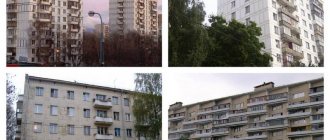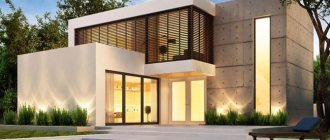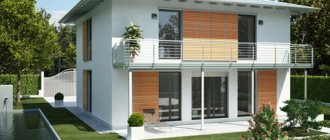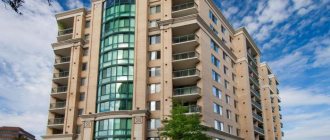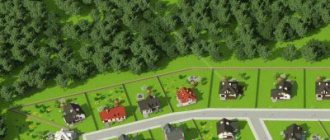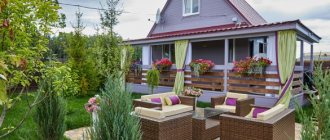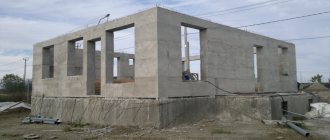New buildings in Moscow are divided into two main types: monolithic housing and panel housing. AiF.ru learned from experts which building is better to buy an apartment in and which construction technology is the future.
Article on the topic Fast, cheap and noisy. What you need to know when buying a home in a panel house
In fact, panel and monolithic houses are almost no different in terms of technology or materials used. The difference is in the method of pouring concrete. “In monolithic construction, it is poured directly on the site. But it is much more difficult to control the quality of work; weather conditions also play an important role. For example, in winter it is necessary to ensure that the concrete is heated, maintaining an optimal temperature. Products for panel houses are manufactured at the factory, under constant supervision and in optimal conditions for the hardening of the mixture. Each panel is tested for compliance with design documentation and regulatory quality requirements. It should also be noted that panel houses are built much faster than monolithic ones, which reduces the developer’s costs,” says Stanislav Shmelev, General Director of PATRIOT-Engineering CJSC .
However, the construction of panel houses is not always profitable. “Due to the fact that not all developers constructing panel houses have their own production facilities, construction technology may be determined by the geography of the future complex. The cost of transporting slabs is quite high, so it is important for the developer to take into account how close or far the construction site is from hypothetically suitable house-building plants,” says Roman Semchishin, director of the investment department of TEKTA GROUP . In addition, it is profitable to build panel houses only where the transport infrastructure allows the panels to be delivered to the site. They are transported in special bulky and heavy vehicles that cannot travel anywhere.
Monolithic buildings
Monolithic houses are a built reinforced concrete structure, used in construction not so long ago. The speed of construction and other qualities of the monolithic structure made it possible to build such houses everywhere. The basis of the house is a reinforced concrete skeleton that does not have load-bearing walls, which allows the layout of the apartment to be free.
This structure makes it possible without much difficulty to combine two rooms, and, if desired, two apartments located both horizontally and vertically. Repair work in such a house will delight you for a long time, since a monolithic house does not leave sediment on the foundation and general skeleton of the building.
The lightweight structure and evenly settled reinforced concrete frame prevent cracks and chips from appearing in the apartment. Walls, floors and ceilings remain smooth after pouring, which allows for the least cost of leveling them. This is the technology that is used in the construction of multi-storey buildings and skyscrapers. Such houses are aesthetically beautiful and will last for more than a century.
Monolithic houses
Monolithic houses
In our country, monolithic structures gained popularity back in the 90s of the last century and have not lost their relevance to this day.
Construction technology
The peculiarity of monolithic technology is the floor-by-floor raising of the formwork around a metal frame into which a concrete solution is poured. Thanks to freely disassembled and assembled formworks, it is possible to pour a concrete structure of any complexity and number of floors. Due to this, each building receives an individual design.
Experts divide the method of constructing a building into the following types:
- Monolithic - a solid monolithic base of the house.
- Monolithic frame - reinforced concrete columns and floors act as frame elements. The filling of the formwork can be not only concrete, but also brick.
Panel structures
When we hear about panel houses, we immediately imagine a low-budget project version of an apartment, with not very high living comfort. This kind of construction was one of the few used in the Soviet years, because reliability, durability, strength and habitability were put into the foundation of the house, but comfort, alas, was not. Considering that the construction of steel panel houses was erected en masse during the first five-year plans, people who survived the war quickly got used to life without comfort.
Despite all the shortcomings, housing is in great demand among current consumers. The design of such houses is undergoing changes, all shortcomings fade into the background. When constructing objects of this kind, designers bring them closer to comfort and try to eliminate the existing shortcomings of previous layouts.
X-Files: what you need to know about panel, brick and monolithic houses?
Before delving into the pros and cons of each material, it is important to understand the developer’s logic. He chooses not the material for construction, as is commonly believed, but the entire construction system. The system is selected based on the segment: whether it will be economy class housing or luxury real estate. Obviously, in the first case, the emphasis is on the speed of construction and the availability of apartments for buyers, in the other - on quality, comfort and the corresponding high price.
Panel houses
In our country, panel houses began to be built en masse in the late 50s; they were supposed to provide housing for as many people as possible. There are about five generations of panel buildings in Russia, the most common being the five-story Khrushchev-era buildings. They, as now, are assembled from separate blocks, it resembles a construction set.
Price:
Panel houses are built quickly and easily; they are the most budget-friendly housing. However, the price for them is not always cheap - it is wrong to assume that panel houses are built exclusively in residential areas or on the outskirts. If land is expensive, the price of an apartment also becomes more expensive.
Term:
Different types of panel houses have their own service life; it is better to look at the documentation of a particular house. For some types of panel houses it can be minimal - fifty years.
Comfort:
Panel houses do not retain heat well and let in a lot of noise. It is difficult to redesign such apartments “for yourself” - the main structures of the house must be preserved, and it will not be possible to move the walls.
In modern conditions, developers can make a panel house with high quality - technology allows for better sealing of seams, this will increase heat and noise insulation. For example, houses made of expanded clay concrete slabs have good sound insulation, and the so-called sandwich panels (a three-layer material that consists of two sheets of metal and insulation between them) retain heat well, but in Russia they are not so common.
Ravil Khasanov - architect-designer, work experience - 12 years:
— The construction period depends on the technology and climate, but on average it is 7–12 months. This is one of the few advantages of this type of construction. Panel houses, in theory, can be made with high quality and correctly, but in reality they are of low build quality; they use cheap technologies and materials.
Panel houses are usually multi-storey - this is a huge wall. When many people live in a house, the areas adjacent to the house are distributed according to standards, and there must be at least minimal amenities - what the city authorities force you to do. This is usually a formal set - horizontal bars or a playground; Naturally, few people think about aesthetics.
Unfortunately, this also applies to work on a panel house as a whole. In theory, a panel house can be made of very high quality, but in practice this is almost impossible to find.
Monolithic houses
Monolithic buildings are a solid structure without seams. Special formwork serves as the main structure into which concrete is poured. For this type of house, a strong foundation is important - usually a concrete base slab, about a meter thick, reinforced with reinforcement. Such houses are very reliable: in the USSR they were built in seismic zones, now monolithic structures are used for reliability in the construction of some parts of military facilities, subways, and cosmodromes.
Monolithic houses began to be built en masse in the 90s, since then they have become increasingly more complex, and developers can choose more and more interesting architectural forms.
Price:
Construction of a monolithic house takes about one and a half to two years. They are relatively inexpensive and popular among people with average incomes. Sometimes this technology is also used in the construction of luxury houses and business class housing.
Term:
If the developer complied with all the standards during construction (the most important requirement is that concreting must be done at a temperature of +5 degrees or higher), then the service life of such a house is quite long - about 100-150 years.
Comfort
: The sound insulation in the house is good, but due to the characteristics of the material, vibration noise and impact noise will be heard - a hammer drill, musical bass. Since solid materials are used in the construction of such a house, they do not allow moisture to pass through - the likelihood that the neighbor above you will flood you becomes less.
Sergey Lobov, architect, work experience - 16 years:
— Monolithic houses are convenient to build, it is technologically advanced and quite fast. The technology itself has taken root in Russia because it is a visually understandable house: if you make the foundation and frame well, then it is impossible to spoil such a house. At the same time, an investor or builder can change the filling material in a monolith and use different architectural forms.
A big plus for the tenant is the small number of supports; you get an apartment with a free layout, which you can make “for yourself” - demolish the walls, attaching only to vertical partitions - risers with water, for example (
We remind you of the need to obtain the appropriate permits - editor's note
).
If I buy an apartment in such a building, I understand that I can rearrange everything - I like this freedom. Brick houses
Brick is a durable material for building a house, and is usually used to build luxury houses. Developers can afford to come up with an original architectural form, since the building is not built in one piece, each brick is laid out separately.
Price:
The highest cost, the construction of such a house is expensive. The construction period is about two and a half years.
Term:
Brick is the most reliable and durable material; if technology is followed, it can last up to 150 years; if the brick is ceramic - even longer. In this type of house, rotting is excluded, and rain, temperature changes, and the sun do not affect the strength of the house even after a long time.
Comfort:
Brick retains heat well, and sound insulation depends not only on the material. If the builders have made high-quality load-bearing structures and partitions, then the insulation will be good, this needs to be checked in a particular house. Often, builders also use additional insulation or hollow bricks, which retain air, so that the apartment retains heat even better.
Ravil Khasanov:
— A brick house can be understood as different types of houses. To me, a classic brick house has brick walls and hollow core panel floors. Now another system is used, when a house is built from a monolithic frame, and it is filled with brick. From the outside it will seem that the house is made of brick, but in fact it will be made of a monolithic frame - and the monolithic layers are very difficult to see.
A classic brick house is really very convenient and comfortable, both in terms of material and infrastructure. Usually it has a small number of floors, such houses are built on expensive land, so most likely, to save money, the developer will build an underground parking lot, and the area around the house, due to the small number of residents, will be quite sufficient.
It is important to pay attention to the foundation of the house - the material is heavy, so the support must be strong. If you buy a brick apartment on the secondary market, carefully inspect the walls for cracks. If the previous residents recently made renovations, then most likely it will be impossible to see them, then inspect the facade. Single cracks are not so dangerous, but many cracks located parallel or fan-shaped should alert you.
How to check an apartment on the secondary market:
Sergey Lobov:
— I sometimes help friends when buying a house - I usually look at the same thing. It is important to know - did the builders use wooden or monolithic floors? If it's wooden, it means you could lose your apartment in a fire. If the ceilings are monolithic, then most likely only the apartment that is the source of the fire will burn. I look at the condition of vertical communications - for example, wear of pipes. Ideally, you need to look into the basement - is there water there? This will determine whether there will be mosquitoes in the house; if the basement is wet, then the foundation will gradually collapse. Very often the basement is wet because the communications are leaky - I’ve seen a lot of houses like this. The fix is very simple - usually you need to connect two plastic pipes, like closing the lid of a jar, but this may not be monitored.
It is necessary to look at the condition of the windows - how the sashes close and open, what is the condition of the beams under the floor, whether the floor is level or not, whether there are cracks on the walls or not. If there is, then he walks, breathes, if you put up wallpaper, this will be an additional inconvenience.
How to check an apartment on the primary market:
Sergey Lobov:
— I look at about the same thing in the new house. The problem is that in this case it is more difficult to understand how it will behave over time. You can focus on indirect signs - if some parts are made with high quality, it means that the foremen tried, worked, and monitored the workers. If it’s not done miraculously, but simply carefully, that’s enough, and such a house inspires trust.
When buying a house, I would not rely on the developer, but would look at a specific house: the infrastructure nearby and around, materials and details. Personally, I have a requirement for my home - it must be beautiful for me personally. In this case, it doesn’t matter to me which company built it, how much the clinker bricks that were used there cost. If the house is aesthetically pleasing on the outside, I’m sure everything inside is also done with high quality; “fake houses” can be found very rarely.
But you can still check the quality of the developer’s work. Ask the developer or look in the project declaration for information about the houses he has already built, you can go and see it with your own eyes. It is best to choose a house that was completed a year or two ago - a longer period will give biased results, because the developer can build better now. Sometimes the territory of the house is closed, but you can negotiate with the developer. Don't be shy about communicating with residents - this way you can meet potential neighbors and get their opinion about the house.
What stereotypes about materials do you want to challenge?
Ravil Khasanov:
- A cheap and good house made of any material can be found in almost any city - it’s only a matter of time. Any house can ideally look, if not pretty, then at least normal. Even the worst facade can be carefully covered with a nice and inexpensive material - it will look good. In practice, this is very rare, but there is a good example - a developer made houses from white sand-lime brick with dark brown wooden inserts - it is very cheap, but it looks neat and even beautiful. In practice, this rarely happens - the chain is too large. The house-building plant must make nice material, and everything at the construction site must be arranged correctly.
But you can also ruin a good façade. It can be simple but cute and well proportioned. Sometimes for some reason it is covered with terrible material, which everyone associates with vulgarity and cheapness. Therefore, it is important to evaluate the tastes of the developer based on previous works.
Sergey Lobov:
— There is a stereotype that luxury housing is always of good quality. In our country, elite housing is a more or less well-built house; in fact, it may not have the qualities of elite housing, speaking from the point of view of Western architecture. In our minds, this includes an underground parking lot, a large apartment area, high ceilings, and two bathrooms. In fact, it is ordinary, just not very scary, and the prefix “elite” adds a percentage to the cost of the apartment. Don't pay attention to the titles, evaluate the apartment itself.
Similarities between monolithic and panel houses
Of course, what is common between monolithic and panel structures is:
- Durability and reliability. Structures made from reinforced concrete and single concrete blocks are strong.
- The durability of a panel house, which has been in the service of the people for decades, is no shorter than that of a monolithic building.
- Environmentally friendly.
- Safety .
Construction of a house from concrete blocks
Today, among building materials, brick is significantly reducing its position, giving way to modern building blocks.
Affordable price is the main reason determining the choice of blocks. At the same time, building a house for permanent residence from blocks is not only cheaper, but also much faster, since such large-sized material in quantity can replace from 4 to 14 ordinary bricks.
Today the building materials market offers the following types of blocks:
- gas blocks;
- foam blocks;
- cinder blocks;
- expanded clay concrete blocks;
- wood concrete;
- shell rock blocks;
- ceramic blocks.
Let's take a closer look at each type.
Gas and foam blocks
Gas and foam blocks have the same technical characteristics and are excellent for the construction of low-rise buildings. They have a more precise dimensional geometry, which affects the thickness of masonry joints, the consumption of expensive masonry mortar, the thermal conductivity of the wall taking into account the masonry mortar, and the labor intensity of masonry. For comparison: the thickness of the masonry for aerated concrete blocks is 1-1.5 mm, and if we talk about ceramic bricks, the thickness of the masonry will range from 10 to 15 mm.
Their only difference is the internal structure of the material.
Aerated blocks are made from a homogeneous mixture of sand, cement and lime with the addition of a special powder - a gas-forming agent, in order to achieve small through channels inside the block. When choosing such a material, it is better to give preference to blocks made using autoclave technology, as they have better strength characteristics.
Construction of a house from aerated blocks Source dizajio.com.ua
Foam blocks, on the contrary, have closed pores inside the material. Such a structure is achieved during production by adding special substances - foaming agents - to the concrete solution. It is worth noting that such production makes it possible to increase the quality of foam blocks, creating additional energy-saving capabilities for the material and significantly reducing its weight. Also, unlike a gas block, whose open channels conduct moisture well, foam blocks do not need additional protection from moisture.
They produce blocks of various formats and thicknesses, which allows the developer to choose the optimal material for individual construction without extra costs for additional insulation. Good geometric data allows you to build houses with a complex structure.
Also, foam blocks and gas blocks do not require complex finishing; this can be done using putty or decorative plaster.
In addition to all the listed advantages, a significant argument in choosing this particular material for construction will be its low cost. The average price on the construction market for 1 m3 is about 3 thousand rubles.
All other building parameters being equal, a house frame made of aerated concrete blocks is cheaper than a house frame made of ceramic blocks. However, further construction operations neutralize this large initial difference.
Among the disadvantages of foam and gas blocks, the following characteristics of these materials can be identified:
- Fragility . Even the highest quality blocks are easily damaged during transportation or during the construction process. Therefore, they should be handled with extreme care.
When comparing wall materials, aerated block, unlike brick, has a lower density.
Block density is a measure of the strength of a block. In most cases, density D500 is used, comparable to concrete strength and grade b3.5. Walls from the d500 block can be used for the construction of up to 3 floors, and with such data it is appropriate to call the material fragile only in comparison with other building materials.
The complex technological process of laying communications reduces the cost of work and materials compared to a frame wall, for example, cables in a brick or block wall can be laid directly into the groove, but in a frame house it is necessary to use a metal hose or metal pipe to ensure the safety of electrical installation, when comparing the two options, complexity and price will come to the same denominator.
Good water absorption - when in contact with water, the block will pick up moisture only on the surface and, due to its structure, will not let moisture in. If we compare it with a ceramic block as an alternative to a gas block, then the gas block will win in terms of the degree of lowest water absorption. The ceramic block in this comparison will get completely wet.
The inorganic chemical elements used are harmless to humans. Aerated block houses are ideal for families, especially for sensitive people: allergy sufferers, asthmatics, family members with respiratory diseases.
The construction of a wall of 375 mm or more is allowed without insulating the facade, making thin vapor-permeable plasters or ventilated facades directly on a massive block wall.
Vapor permeability is the main advantage among other building materials.
Direct speech: Mikhail Dyachenko, General Director of DOM ABS LLC
- High water permeability (for gas blocks) . This requires the inclusion of additional work during construction in order to create conditions for the safety of structures inside and outside the building.
- Mandatory external and internal decoration of the house . When building a house from aerated concrete blocks, it is very important to pay special attention to the thermal efficiency of the walls of the building: the thermal resistance should not be less than 3 units. Do not skimp on wall thickness and materials. Otherwise, you will end up with a situation where the plaster falls off, cracks appear on the walls, and condensation accumulates on the walls inside the house, which leads to the development of foci of fungal infections.
- Presence of chemical elements in the composition.
- All technological operations are more complex . For example, laying communications in the natural cavities of the walls of a frame house will not cause any special difficulties. But when it comes to a stone or brick house, the volume and complexity of the work increases significantly.
The difference between a monolithic and panel building
There are a number of differences between monolithic and panel structures:
- Low level of comfort for living in panel houses than in monolithic ones.
- In panel houses, the thermal insulation is low , and this is due to the fact that concrete practically does not retain heat in winter. The joints have poor insulation, due to which it is cool in such houses, the end walls especially suffer. In summer, concrete heats up perfectly, making the room stuffy and almost impossible to breathe. This feature of concrete leads to dampness and mold. There is no such problem in monolithic structures.
- Poor quality roofing . The main task of housing and communal services is the replacement of roofing. Due to shortcomings in this direction, the last floors are subject to frequent repairs due to leaks, however, leaks also occur between floors; it is not difficult to flood neighbors and the reason for this is poorly insulated joints. Monolithic frames are completely filled and such questions do not arise.
- The foundation of a monolithic house is completely poured; dampness does not accumulate in such apartments, which cannot be said about a panel house in which the first floors have lost their relevance among buyers. And the reason for this was the lack of sealing between the first floor and the room below it (basement).
- Another difference is sound insulation , which in panel houses leaves much to be desired; in apartments, people practically live with the problems of their neighbors, which is not what you will find in a monolithic house.
- The constant noise of the elevator shaft, consisting mainly of the passenger cabin of a panel house, and the silent elevators from the passenger and cargo cabins in monolithic buildings is another difference.
- Panel buildings are cement blocks connected to each other, which are completely load-bearing walls, which makes it impossible to change the interior. There are no such problems in a monolithic structure; all such houses have an open layout; this design allows you to increase the area of the room by combining two rooms or apartments.
- Appearance . Panel houses are not sheathed on the outside with anything. They are whitened with whitewash, in most cases. Over time, the color of the white fades, some of it is washed away by precipitation, which leads to the loss of the appearance of the building. Monolithic houses are sheathed with various cladding materials, be it brick or tile, which preserves their beautiful appearance longer.
- Construction prospects . There is an opinion that construction companies will soon abandon the construction of panel houses, at least in megacities. Despite the improvement of projects, the comfort in such houses is inferior to other buildings made of monolith and brick. Monolithic houses, on the contrary, are gaining momentum in the construction industry.
- And finally, this is the budget . The costs of a panel house are low. This housing will be available to a buyer who does not have large financial resources. That is why it is still in demand among consumers. An apartment in a monolithic building is not a cheap purchase, but people increasingly prefer it due to its comfort.
Brick houses
The construction of brick houses is one of the oldest technologies. Modern brick houses are built less frequently and are mostly low-rise.
Advantages
- Warm apartments. Since brick has good thermal conductivity, such apartments are warm in winter, and, on the contrary, cool in summer when it’s hot. Brick walls are very thick and they do not need additional insulation.
- I can't hear my neighbors. Brick has one of the best sound insulation compared to other materials. Therefore, in such a house you will not only not hear your neighbors, even the sounds of repairs will not cause such inconvenience as in a “socket” or “monolith”.
- Durability and reliability. Brick is considered the most comfortable material for housing. Because the buildings are durable and reliable in operation.
- Environmental friendliness . According to experts, it is much easier to breathe in brick houses, and the appearance of fungus and mold is minimized there. Because this material absorbs moisture well and also releases it well.
- Individual design . New brick houses very rarely have standard layouts. Therefore, the buyer has a choice; they can order an apartment according to their design from planners. In addition, with the help of brick you can play with architecture, and externally such houses often look much more aesthetically pleasing than their panel “brothers”.
Which structure should the consumer choose?
Monolithic house for a person who loves a measured lifestyle. People who prefer a high floor for living can live in such a house. This type of housing is suitable for those who want to implement design solutions in their apartment. Moreover, such housing is ideal for a mortgage for young families.
An apartment in a panel house is suitable for people who do not have great financial resources. Yes, an apartment in such a house will be far from ideal, but a non-spoiled layman will be able to make the interior more comfortable, and for this you need to soundproof and heat insulate the apartment.
Considering the qualities of monolithic and panel houses, the choice seems obvious. The advantages of a monolithic structure are much greater than those of a panel structure. But the choice is yours.
Repair and constructionComment
What technology is the future?
Expert opinions are divided on which technology is the future. “For monolithic housing construction,” says Daria Tretyakova. “The price level between panel and monolithic new buildings in individual locations differs slightly, and the panel wins only in terms of the pace of construction.”
“Panel housing construction has the greatest prospects,” believes Roman Semchishin. — Now all of Europe has switched to this technology, so over time Russia will come to this. Already, many DSK are actively developing their production taking into account the use of modern technologies and materials.”
Article on the topic
Summer real estate prices. How much does an apartment in Moscow cost now?
“In fact, the future lies in a combination of technologies,” Stanislav Shmelev is sure. “And this is not just my opinion - this is the path that all developed countries are now following. Smart design allows you to take the best from each technology and get high-quality, affordable housing that is built quickly and looks great.”
Question answer
Question: How is reconstruction carried out in monolithic, block and panel buildings?
Answer: Of course, reconstruction in each type of house occurs in its own way. Thus, during repairs in a monolith, one should take into account the fact that the structure “sits” for a long time, that is, shrinkage proceeds slowly.
In buildings made from panels, shrinkage also takes a long time. Therefore, the joints between load-bearing walls and between walls with a balcony must be considered especially carefully. Reconstruction in block buildings is not much different from this process in panel houses: here you also need to take into account the joints between the walls and the shrinkage of the house.
Question: What are the features of renovation of each type of building?
Answer: Repairs to a monolith can be done a short period of time after moving in, since shrinkage will not be so pronounced. But in buildings made of panels and blocks, only minor cosmetic repairs can be made when moving. Only after 1-2 years is it permissible to begin a full reconstruction of the apartment.
In any case, each housing option has its pros and cons. The main thing is to take them into account, and then the apartment will delight its residents for many years.
You may also be interested in: Which floor is better to live on?
House types
No matter how far new technologies in construction have advanced, the most common building materials today are brick, concrete and wooden structures.
Which house is better: brick, monolithic or panel?
Reinforced concrete buildings are the strongest and most durable . But for the Russian climate, they are not the most economical in terms of thermal conductivity, and in terms of preserving human health, they are not the most comfortable.
The components that make up concrete can be radioactive (this is a property of all natural minerals) . That’s why almost all concrete “sounds.” The radiation factor from concrete can lead to negative consequences for the human body: from breathing problems to multiple sclerosis.
Read the article, the secrets of a new building, instructions for registering an apartment as your property here.
Floor slabs that have a lot of weight at high elevations can create a certain stress and affect a person’s well-being . For residential buildings, such building material will not always be the optimal choice.
Wooden houses are characterized as the most environmentally friendly for humans.
Such houses are inexpensive, can be located on unsteady soils, are easier to withstand earthquakes, have excellent thermal insulation qualities and natural air exchange with the external environment. Dangerous factors will be fires, insects, time.
Brick houses are stronger than wooden ones, resistant to fire, easy to build on at any time, not susceptible to attack by various insects, and have good sound insulation.
Panel houses are characterized by a rigid architectural design, lack of redevelopment possibilities, poor sound insulation due to thin partitions, and poor-quality seams between panels.
The advantages of such houses include the speed and cost of construction. Modern construction is beginning to use seamless installation technology.
Houses using foam materials (thermohouses) are controversial in terms of ecology, durability and safety. The environmental friendliness, thermal insulation and durability for which foam materials were famous are currently under big question.
Features of monolithic construction of residential complexes
If we are talking about the balance of cost, timing and quality, then monolithic brick technology still remains the leader. Despite the successes of designers in monolithic solutions, they remain less in demand. The reason for this is the technological features of monolithic construction.
Let us recall that monolithic technology is based on the use of a large mass of concrete, which is continuously poured into the formwork until an entire floor or level is formed. In this way, you can create a structure with a central core or transfer structural loads to load-bearing external walls and columns. The benefit is that the interior space remains available for free planning, and the building itself turns out to be virtually intact, with a minimum number of seams and joints. It is not afraid of deformation and shrinkage, stands confidently on heaving soils, and does not create additional load on the base.
Reviews from residents
When looking for a type of housing, it is important to hear reviews about it - this will make it easier to navigate the choice of building.
Reviews of monolith buildings
I have been living in a monolithic building for several years now and am very pleased with the choice. In winter it’s warm, turn off all batteries. Audibility is moderate.
Svetlana
A little over a year ago we purchased an apartment in a monolith. We are happy with the temperature: in the frost -40 in the apartment the temperature did not drop below +24 degrees. But there are problems with sound insulation: recently the neighbors celebrated a holiday, and in our apartment it was heard as if we were holding the event ourselves.
Oksana
I live in a monolithic frame building. Satisfied with almost everything, only problems with sound insulation. Since the neighbors are doing renovations and families with small children live in the house, it’s impossible to be quiet.
Andrey
Reviews about buildings made of blocks
We have been living in a block house for 5-6 years. It’s warm, and you can hardly hear any sounds behind the wall. If they do, it’s only in the bathroom because of the riser or because the neighbors have a through socket. Very pleased with the choice.
Tatiana
I recently moved into a block house. I am pleased with the quality of the construction, as well as the sound insulation. You can’t hear the neighbors on the side at all, and those on top only when you turn on the washing machine. Overall, a good impression of block buildings.
Sergey
Reviews of housing made from panels
We recently moved into a panel building, but immediately felt that even plastic windows did not protect us from the cold. Sound insulation is also not the best.
Maria
I, as a person who has lived in a panel house for 10 years, can say that the main problem with such buildings is the walls that move. Because of this, the wallpaper wrinkles at the joints of the walls and needs to be constantly re-glued.
Michael
